antique clocks, watches,
barometers & instruments
www.antique-horology.org
The
H o r o l o g i c a l F o u n d a t i o n
|
antique clocks, watches,
barometers & instruments |
|
|
|
|
||
|
Guidance in
making write-ups
(descriptions) of a bracket clock for those whose native language
is not English.
Tip: Click either the red numbers on the pictures or an index item below. AlarumAutomaton Backplate 1 Basket/Bell top 15 Break arch 2 Carrying handle Cartouche Case 7 Chapter ring 9 Day of the month aperture 16 Dial 6 Escutcheons 4 Feet Finials Fret 5 Front door Side Half-hour markers Hands 14 Maker 13 Mock pendulum aperture |
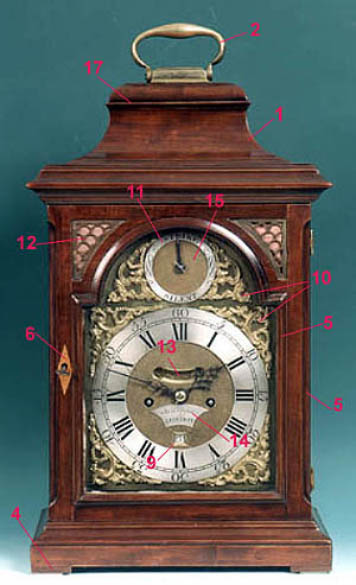 |
|
Movement |
|
|
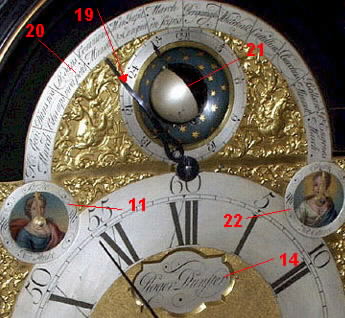 |
||
|
|
||
| Subjects | Possible 'write up’s' | |
| Alarum |
|
, the tail of the hour hand acting as the pointer for the central silvered alarm disc numbered 1-12 |
| Automaton |
|
The breakarch dial has
a large cutout to the top in the form of a stage. A painted scene
within this depicts a husband and wife playing cards whilst
automaton figures on either side move across from either side to
serve them at the hour, one with a loaf and the other fish. In the arch is a beautifully painted garden scene with houses alongside which overlook an estuary. A lady and gentleman are apparently hitting a ball between each other with their rackets whilst another lady and gentleman look on. |
| Backplate |
|
..a beautifully
engraved backplate, including the maker's signature... The back plate is delicately engraved and includes the maker's signature. ..the backplate profusely engraved with tulips and leaves. .. and a beautiful florally engraved backplate. The brackets are also engraved. ..and a beautiful florally engraved backplate with a casket of flowers in the centre. Superbly engraved back plate which is signed by the maker. |
| Basket top |
|
The ebony case, with gilt repoussé basket top and carrying handle. |
| Break arch |
|
The break arch brass dial is mounted with rococo spandrels |
| Carrying handle |
|
, the shallow bell top
case is veneered with fruitwood with an ebonized finish, with a
brass moulding to the door and a single brass carrying handle
above. |
| Cartouche |
|
a silvered chapter ring and two subsidiary dials in the arch for strike/silent and rise and fall regulation flanking a cartouche signed by the maker. |
| Case |
|
The ebony veneered
case, with gilt basket top and carrying handle. .. , the shallow bell top case is veneered with fruitwood with an ebonized finish, with a brass moulding to the door and a single brass carrying handle above. The case, in bell top form, with canted corners and moulded brass feet, is veneered with well figured mahogany of excellent colour and good patination. All four corners of the case are canted and decorated with caryatids and with floral decoration below. The small ebony veneered case stands on ebonized bun feet adorned with gilt brass leaves. The case of this clock is quite outstanding, having an excellent patination and being of a most attractive colour, closely resembling a mellow walnut. The bell top has a carrying handle and a brass mould interposed between its' upper and lower sections. The classic and
beautifully figured mahogany case has a breakarch top surmounted
by three ball and spire finials resting on fluted wooden blocks. ..extensively decorated with fine rococo ormolu mounts. The inverted bell top case of ebony is finely proportioned and has brass pillars, feet and inlay .. The inverted bell top case is of ebony on fruitwood and is finely decorated with brass and fretwork. The carved case is quite outstanding. The case is in the curvaceous style of this period with carved swags of leaves and a well carved pineapple finial, a very distinctive style which lasted for only ten years. The front of the clock has a flame veneer. |
| Chapter ring |
|
The engraved and
silvered chapter ring has Roman hour and Arabic minute numerals. and has a raised chapter ring with outer Arabic minute numerals and inner Roman for the hours, between each of which are decorative half hour marks. The raised engraved
and silvered chapter ring employs roman numerals and bears the
makers signature at 6 o'clock. |
| Day of the month aperture |
|
The centre is finely
matted with an aperture to view the day of the month and there is
a strike/silent option above 12 o'clock.
The dial centre is matted and has a date aperture at 6 o’clock; the makers name plaque above this and a mock bob below 12 o’clock. There is an engraved cartouche around the date aperture ..day of the month aperture within an engraved cartouche, |
| Dial |
|
Both dial and
backplate are signed by the maker. The 7ins square brass dial is mounted with a silvered chapter ring and wing cherub spandrels to the corners. ..The centre is finely matted with an aperture to view the day of the month and there is a strike/silent option above 12 o'clock. The break arch brass dial is mounted with rococo spandrels. The brass dial has
an engraved and silvered brass chapter ring with quartering on
it’s inner aspect and half hour marks which bears the maker’s
signature on either side. The centre is matted with ringed winding
holes . There is an engraved cartouche around the date aperture
and the later form of cherub spandrels with flowers are employed.
The well executed blue steel hands are original. ..square 8-inch dial with calendar and mock pendulum, strike/silent at IX, signed John Ingram Spalding fecit. Wheat ear engraving to border. The dial centre is finely matted and the blued steel pointers are pierced and facetted. The gilt dial with silvered Roman and Arabic chapter ring with sword-hilt half-hour markers, typical pierced blued steel hands, matted centre, finely chased winged cherub spandrels. The 7" brass dial has well executed rococo spandrels, two of which flank the narrow strike/silent ring in the arch. This has a well-matted centre. The engraved and silvered chapter ring has Roman hour and Arabic minute numerals. There is an attractively shaped aperture with bevelled edges below 12 0'clock behind which is the makers' signature on a silvered plaque. The dial centre is very finely matted and there is a date aperture above 6 o'clock. The enamel dial and subsidiary dials set within a finely engraved gilt surround and bearing the makers signature which is repeated to the well engraved backplate. The signed and numbered dial with subsidiary dials for strike/silent and rise/fall regulation and fine gilt scroll and cherub spandrels. The silvered dial and the movement carry the serial number 2000 which dates the clock to 1859. Fine, early painted dial bracket clock with rose corners, strike/silent to the arch. There are subsidiary dials to the arch for strike/ silent and music/ silent. |
| Escutcheons |
|
There are gilt brass
foliate escutcheons to the door side rails.. Decorative escutcheons have been applied to the front and back doors, |
| Feet |
|
Standing on four
moulded brass block feet The case, in bell top form, with canted corners and moulded brass feet. The small ebony veneered case stands on ebonized bun feet adorned with gilt brass leaves. The clock rests on its' original brass bracket feet. The sides of the case, with carrying handles, have well executed silk backed gilded cast brass frets |
| Finials |
|
There are four
pineapple finials and attractive cast brass frets to the top
corners of the front door which has a brass mould around its'
inner edge and fluted front corners. There is a carrying handle on top and finials to the four corners. The central finial on top rests on a block with frets to either side. There are four further pineapple finials to the top of the case. The classic and beautifully figured mahogany case has a breakarch top surmounted by three ball and spire finials resting on fluted wooden blocks. |
| Fret |
|
To the front and
sides are finely pierced frets against a red silk background.
There are four pineapple finials and attractive cast brass frets to the top corners of the front door. The central finial on top rests on a block with frets to either side. ..have well executed silk backed gilded cast brass frets. There is fine fretwork to each side of the case to let out the sound of the chimes. (or bells) ..with four finials to the hood and frets to each side to release the sound of the music. |
| Front door |
|
of the front door which has a brass mould around its' inner edge and fluted front corners. |
| Going train |
|
|
| Half-hour markers |
|
The gilt dial with
silvered Roman and Arabic chapter ring with sword-hilt half-hour
markers. ..and has a raised chapter ring with outer Arabic minute numerals and inner Roman for the hours, between each of which are decorative half hour marks. The chapter ring has fleur-de-lis half hour marks Cross half quarter markers. |
| Hands |
|
The blued steel hands
are finely pierced and facetted.
.. and the blued steel pointers are pierced and facetted. .. with a very beautiful pair of pierced gilt brass hands for the hours and minutes and pierced blued steel hand for the calendar indications. The well executed blue steel hands are original. |
| Maker |
|
This clock, which
dates from c1820, can be attributed to Benjamin Lewis Vulliamy.
Charles Cabrier is
considered an outstanding maker and has examples of his work at
The Royal Museum in Stockholm. He is also recorded as making a
fine clock for the King of Peking. The backplate is beautifully engraved with tulips and includes the maker's signature within a lambrequin. The dial centre is matted and has a date aperture at 6 o’clock; the makers name plaque above this and a mock bob below 12 o’clock. James Tregent, a famous maker, is first recorded as working circa 1759 and was a member of the Clockmaker's Company from 1781 - 1808. He was watchmaker to the Prince of Wales.
An oval plaque carries
the maker’s name. The raised engraved and silvered chapter ring employs roman numerals and bears the makers signature at 6 o'clock. ..a date aperture at the bottom and a curved silvered brass strip carrying the maker’s signature. A William IV mahogany bracket clock c1835 by the noted London makers, Brockbank & Atkins. The enamel dial and subsidiary dials set within a finely engraved gilt surround and bearing the makers signature which is repeated to the well engraved backplate. Scalloped name plate. |
| Mock pendulum aperture |
|
The gilt dial with
silvered Roman and Arabic chapter ring with sword-hilt half-hour
markers, typical pierced blued steel hands, matted centre with
mock pendulum aperature... The dial centre is matted and has a date aperture at 6 o’clock; the makers name plaque above this and a mock bob below 12 o’clock. The clock also with a false pendulum aperture in the arch and makers signature below, |
| Movement |
|
The twin fusee, eight
day duration movement with verge escapement The twin fusée movement originally had a verge escapement, but has been altered to the later anchor escapement The silvered dial and the movement carry the serial number 2000 which dates the clock to 1859.
The fine quality five
pillar striking and repeating movement has a verge escapement and
a beautiful florally engraved backplate. The brackets are also
engraved. |
| Moon phase |
|
The break-arch dial
with rolling moon phase above the chapter ring. The brass dial showing the moon's phases in the arch with the hemispheres on either side. The 13" dial is a fine feature of the clock with the globe moon, half silvered and half blue, rotating in a recess in the arch surrounded by a turned brass ring. Immediately above it is a horizontally rotating lunar calendar and to either side dolphin spandrels. |
| Musical tunes |
|
..plays one of two tunes
at the hour employing eight bells and fifteen hammers. There is a date aperture above 6 o’clock and tune selection lever at 3 o’clock. The movement with 8 day duration and striking the hour and playing the selected dance from a choice of four melodies. The tunes are March, Minuet, Gavotte, Jig and Garrotte, and played each hour on a carillon of 13 bells. They are engraved across the dial arch and selected by a sweep tune hand. .. with 4 finials to the hood and frets to each side to release the sound of the music. Rare three train musical movement playing on a carillon of eight bells. This fine carillon clock plays four airs on twelve bells once every hour. There are subsidiary dials to the arch for strike/ silent and music/ silent. An outstanding musical bracket clock by one of the most respected clockmakers of his time, specialising in clocks for the Turkish market and musical clocks in particular. |
| Repeater |
|
The two train, eight
day duration, fusee movement has a verge escapement and quarter
repeat mechanism operated by a push-pull bar protruding from
either side of the case.
.. full quarter repeat on two bells via Tompion's single-cocked steel bar system with hinged levers and pull cords from either side. The five pillar movement with verge escapement and pull quarter repeat on six bells There are pull repeat cords for the hour strike and music. |
| Side |
|
The sides of the case are glazed with a brass mould running around the edge of the circular upper and shaped lower apertures. |
| Size & Proportions |
A fine George III
mahogany and gilt mounted bracket clock of small proportions and
original condition. The inverted bell top case of ebony is finely proportioned and has brass pillars, feet and inlay .. |
|
| Spandrels |
|
The break arch brass
dial is mounted with rococo spandrels. .. finely chased winged cherub spandrels.
.. early spandrels retaining superb and original mercury gilding
now worn through in the high areas. There is an engraved cartouche around the date aperture and the later form of cherub spandrels with flowers are employed. The main part of the dial employs female mask spandrels and has a raised chapter ring with outer Arabic minute numerals and inner Roman for the hours, between each of which are decorative half hour marks. dial with dolphin spandrels in the arch flanking the strike/silent ring, which is decorated with engraving. The corners of the dial have urn spandrels and the dial centre, which is well matted, has a date aperture. Indian mask spandrels. Scroll and cherub spandrels. |
| Strike silent option |
|
The centre is finely
matted with an aperture to view the day of the month and there is
a strike/silent option above 12 o'clock
The 7" brass dial has well executed rococo spandrels, two of which flank the narrow strike/silent ring in the arch. |
| Striking train |
|
The two train fusee
movement has an eight day duration with the quarters sounded on
four bells and the hours on a separate bell. The hours are sounded on a large bell and the quarters on a small bell A rare and fine George III ebony veneered three train quarter striking racket clock. The 8 day Dutch striking movement with verge escapement and phases of the moon. Playing each quarter hour on four gongs and each hour on a single gong. There are subsidiary dials to the arch for strike/ silent and music/ silent. |
| Top of case |
|
, the shallow bell top
case is veneered with fruitwood with an ebonized finish.
The bell top has a carrying handle and a brass mould interposed between its' upper and lower sections. The impressive ebonised case has a bell top with a brass mould between the two tiers and below the bottom one. The central finial on top rests on a block with frets to either side. There are four further pineapple finials to the top of the case. The bell top has a decorative mount to the front. The classic and beautifully figured mahogany case has a breakarch top surmounted by three ball and spire finials resting on fluted wooden blocks. |
|
Winding hole |
|
The centre is matted with ringed winding holes |
|
|
||
|
|
Sample text | |
|
Title: quality/status, style, type, maker, place, date. |
A most imposing, George III, bracket clock by Thomas Wagstaff London, ca 1775. | |
|
Case: quality, type, design particulars, material, components and ornaments. |
The attractive case, in bell top form, with canted corners and moulded brass feet, is veneered with well figured mahogany of excellent colour and good patination. There are brass carrying handles to the sides, flambeau finials to the four corners and a single flambeau finial on the wooden mount to the centre of the bell top. | |
|
Dial: quality, type, material, features, components, ornaments. |
The well executed break arch brass dial is mounted with a silvered chapter ring which includes the maker's signature, a strike/silent option in the arch and rococo spandrels. The centre is matted and there is an aperture to view the day of the month. | |
|
Movement: quality, duration, material, construction, escapement, striking repeating musical features. |
The fine quality, eight-day duration, three train, fusee movement includes a verge escapement and hour strike sounded on a bell. The quarters are sounded on seven bells and there is a pull repeat mechanism. | |
|
Maker or origine: give as much information as possible on the maker and or region of manufacturing. |
Thomas Wagstaff is recorded as working at 33 Gracechurch Street
London from 1766 to 1794. He was a Quaker and a Member of the Society of Friends and was responsible for making many three train bracket and longcase clocks. |
|
|
Dimensions: H= height W= width D= depth L= length Diam= diameter |
Height excluding handle : 46 cm. (18") |
|
|
Literature (acknowledgements): state where similar objects are described or exhibited, and the source of the makers biographical particulars. |
A longcase and bracket clock of this maker are in the Virginia museum. Watches are in the Metropalitan Museum of Art in New York, The Dennison collection and Ilbert collection. Lit: G.H. Baillie, Watchmakers and Clockmakers of the World. |
|
|
Tip: Be careful when using 'promotional' terms |
Like: most imposing, attractive, well executed, good, fine, very fine, impressive, well proportioned, fine quality, extremely rare, important, beautifully executed, extraordinary, outstanding, |
|
|
|
||
|
|
||
 |
A FINE MUSICAL BRACKET
CLOCK WITH AUTOMATON SCENE IN THE ARCH. CIRCA1780. This clock, which has a very fine six pillar three train movement with verge escapement and a beautiful florally engraved backplate with a casket of flowers in the centre, plays one of two tunes at the hour employing eight bells and fifteen hammers. The flat topped breakarch dial has a large cutout to the top in the form of a stage. A painted scene within this depicts a husband and wife playing cards whilst automaton figures on either side move across from either side to serve them at the hour, one with a loaf and the other fish. There are rococo spandrels, a narrow engraved and silvered chapter ring and matted dial centre. There is a date aperture above 6 o’clock and tune selection lever at 3 o’clock. The impressive ebonised case has a bell top with a brass mould between the two tiers and below the bottom one. The central finial on top rests on a block with frets to either side. There are four further pineapple finials to the top of the case. The bell top has a decorative mount to the front. The sides of the case, with carrying handles, have well executed silk backed gilded cast brass frets. All four corners of the case are canted and decorated with caryatids and with floral decoration below. |
|
 |
|
A FRUITWOOD VENEERED
BELL TOP BRACKET CLOCK WITH PULL-QUARTER REPEAT ON SIX BELLS.
CIRCA 1780. This well proportioned clock, of a pleasing warm colour, has a carrying handle on top and brass frets to either side of the case and the top of the front door. The 7" brass dial has rococo spandrels to the four corners and on either side of the strike/silent regulation. The dial centre is matted and has a date aperture at 6 o’clock; the makers name plaque above this and a mock bob below 12 o’clock. The chapter ring has Roman hour and Arabic minute numerals. The five pillar movement with verge escapement and pull quarter repeat on six bells, has a beautifully engraved backplate with a mythical bird in the centre together with floral engraving. Height excluding handle : 18" ( 46 cms.) |
 |
|
A rare William & Mary,
quarter repeating, spring bracket clock by the eminent maker Daniel Quare. The ebony case, with gilt basket top and carrying handle. The twin fusee, eight day duration movement with verge escapement and beautifully engraved backplate, including the maker's signature. |
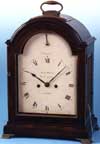 |
|
A GOOD EARLY 19TH
CENTURY BRACKET CLOCK. The twin fuzee movement bears McCabes’ signature within a cartouche on the backplate which has engraving to the four corners and the border. The pendulum is also decorated and the rod is graduated for fine regulation. It strikes and repeats the hours on a gong. The 8" painted dial, still retaining its’ original ground, has light Roman numerals and strike/silent regulation in the arch. The breakarch case has a brass bound pad on top with carrying handle and there are brass fish scale frets to either side. The inside of the front door has a brass mould. It is likely that the case, veneered in fruitwood, was originally ebonised but is now a mahogany colour. Height, excluding handle : 16" ( 41 cms.) |
 |
|
A very fine Regency bracket clock by this eminent maker. Standing on four moulded brass block feet, the shallow bell top case is veneered with fruitwood with an ebonized finish, with a brass moulding to the door and a single brass carrying handle above. To the front and sides are finely pierced frets against a red silk background. The break arch brass dial is mounted with rococo spandrels, a silvered chapter ring and two subsidiary dials in the arch for strike/silent and rise and fall regulation flanking a cartouche signed by the maker. The centre is finely matted with an aperture to view the day of the month and having finely pierced blued steel pointers. The twin fusee movement includes an anchor escapement and hour strike sounded on a bell. The back plate is delicately engraved and includes the maker's signature. This clock, which dates from c1820, can be attributed to Benjamin Lewis Vulliamy. |
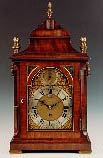 |
|
A most imposing,
George III, quarter chiming bracket clock. The case, in bell top form, with canted corners and moulded brass feet, is veneered with well figured mahogany of excellent colour and good patination. There are brass carrying handles to the sides, flambeau finials to the four corners and a single flambeau finial on the wooden mount to the centre of the bell top. The break arch brass dial is mounted with a silvered chapter ring which includes the maker's signature, a strike/silent option in the arch and rococo spandrels. The centre is matted and there is an aperture to view the day of the month. The eight-day duration, three train, fusee movement includes a verge escapement and hour strike sounded on a bell. The quarters are sounded on seven bells and there is a pull repeat mechanism. |
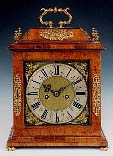 |
|
A fine and rare,
William & Mary, quarter repeating spring bracket clock in a case veneered with kingwood and ordained with gilt brass mounts. The 7ins square brass dial is mounted with a silvered chapter ring and wing cherub spandrels to the corners. The centre is finely matted with an aperture to view the day of the month and there is a strike/silent option above 12 o'clock. The blued steel hands are finely pierced and facetted. The two train fusee movement has an eight day duration with the quarters sounded on four bells and the hours on a separate bell. The escapement is verge and the backplate profusely engraved with tulips and leaves. Both dial and backplate are signed by the maker. |
 |
|
A rare and small,
Charles II, quarter repeating spring table clock. The small ebony veneered case stands on ebonized bun feet adorned with gilt brass leaves. There are gilt brass foliate escutcheons to the door side rails and the cushion top has gilt brass repousee foliage mounts to the four sides and a gilt brass carrying handle. The 6½ ins square brass dial is mounted with a silvered chapter ring and winged cherub spandrels. The dial centre is finely matted and the blued steel pointers are pierced and facetted. The two train, eight day duration, fusee movement has a verge escapement and quarter repeat mechanism operated by a push-pull bar protruding from either side of the case. The hours are sounded on a large bell and the quarters on a small bell. The backplate is beautifully engraved with tulips and includes the maker's signature within a lambrequin. |
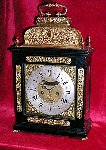 |
|
A fine 17th Century
ebony veneered bracket clock with double basket, square 8-inch
dial with calendar and mock pendulum; strike/silent at IX signed
John Ingram Spalding fecit. Wheat ear engraving to border.
Knife-edge striking verge movement with profusely engraved
backplate and apron. c. 1690 Height 20" £14,000 |
|
|
|
AN IMPORTANT EARLY
VIENNESE BRACKET CLOCK An extremely rare and fine quality miniature eighteenth century Viennese ebonised bracket clock with enamel panels of one day duration, signed on the silvered chapter ring Ph Simon Wienn. The engraved brass arch dial with subsidiary silvered strike/silent (Nicht/Schlagt) ring above the main silvered dial ring with Roman and Arabic numerals and finely sculptured brass hands for the minutes and hours, the tail of the hour hand acting as the pointer for the central silvered alarm disc numbered 1-12, and above a mock pendulum aperture with sliding moon faces. The fusee movement with verge escapement, alarm with pull repeat, striking on the hour and half hour on a single bell. The ebonised case with inverted bell top surmounted by a gilt brass handle and flanked by four gilt brass finials at each corner, with painted enamel quarter panels to the front door, two further shaped enamel panels on the sides and another to the back door, depicting various exploits of Mercury and other mythological gods and goddesses, on latter turned gilt brass feet Vienna, date circa 1735-45 Height 31 cm, width 15 cm, depth 10.5 cm. |
 |
|
An exceptionally fine
Regency mahogany and ebony seven-tune moon dial bracket clock
signed on the white enamel dial Michael Schwartz London and
engraved with the initials G.K. on the original winding key. The
break-arch enamelled dial with rolling moon phase against a blue
sky with gold stars in the arch above the white enamel chapter
ring with outer Arabic minute numerals and very rare 24 hour ring
numbered I-XII for a.m. and I-XII for p.m. and inner Arabic
numerals for the 31 days of the month, with a very beautiful pair
of pierced gilt brass hands for the hours and minutes and pierced
blued steel hand for the calendar indications. The gilt brass
bezel surrounded by a finely floral painted dial mask with two
subsidiary dials, one to the top left for strike/silent and to the
top right for musical selections for the following: Psalm 104
Sunday/ Highland Laddy Monday/ Lango Lee Tuesday/ Hornpipe
Wednesday/ The Waterman Thursday/ Young Colin Friday/ Sawney O'Er
the Lee Saturday. The glazed door opening to adjust two ruby-like
gems below the dial that can be turned for option of releasing or
blocking the music. The movement with rare triple chain fusee,
verge escapement with unusual feature of horizontally aligned
teeth to the escape wheel, the music playing every three hours and
rare feature of automatically changing the tune each day of the
week on twelve bells via fifteen hammers, with hour strike on a
single bell and pull quarter repeat on six bells via separate
hammers. The whole backplate profusely engraved with foliate
scrolls and pendulum bob with an engraved sunburst. The
exceptionally fine mahogany and ebony lancet-shaped case
surmounted by a gadrooned finial and four further gadrooned
finials at the four corners above gilt brass mounted ebony pillars
either side of the glazed arch-shaped dial door with circular
pierced soundfrets to each side, on gadrooned ball feet, two brass
catches under the case which when released enable the whole
cabinet to be removed thus revealing the extraordinary and
beautifully complex movement London, date circa 1825 Height 67 cm, width 39 cm, depth 34 cm. |
.jpg) |
|
A Charles II ebonised
quarter repeating bracket timepiece Thomas Tompion, london no. 42,
circa 1685. The gilt dial with silvered Roman and Arabic chapter ring with sword-hilt half-hour markers, typical pierced blued steel hands, matted centre, finely chased winged cherub spandrels, signed below the chapter ring Tho'.Tompion Londini Feat, latches to the dial feet and to the five ringed pillars of the single gut fusee movement, verge escapement, full quarter repeat on two bells via Tompion's single-cocked steel bar system with hinged levers and pull cords from either side, the large backplate with best quality tulip engraving within scrolling foliage, the signature repeated within a rectangular reserve Tho: Tompion Londini Fecit, the backplate punched numbered 42 once at the base in the center and again in the top left comer, the case with typical laurel-tied facetted gilt handle to the cushion moulded top applied with foliate gilt-metal mounts, foliate giltmetal soundfrets and escutcheons to the front door, glazed sides and rear door 12in. (30.5cm.) high |
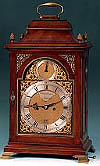
|
|
A GEORGE III MAHOGANY
BELL TOP BRACKET CLOCK OF THE VERY FINEST QUALITY. The case of this clock is quite outstanding, having an excellent patination and being of a most attractive colour, closely resembling a mellow walnut.The bell top has a carrying handle and a brass mould interposed between its' upper and lower sections. There are four pineapple finials and attractive cast brass frets to the top corners of the front door which has a brass mould around its' inner edge and fluted front corners. The sides of the case are glazed with a brass mould running around the edge of the circular upper and shaped lower apertures. The clock rests on its' original brass bracket feet. The fine quality five pillar striking and repeating movement has a verge escapement and a beautiful florally engraved backplate. The brackets are also engraved. The 7" brass dial has well executed rococo spandrels, two of which flank the narrow strike/silent ring in the arch. This has a well matted centre. The engraved and silvered chapter ring has Roman hour and Arabic minute numerals. There is an attractively shaped aperture with bevelled edges below 12 0'clock behind which is the makers' signature on a silvered plaque. The dial centre is very finely matted and there is a date aperture above 6 o'clock. Height excluding handle : 17.8" ( 45.5 cms.) James Tregent, a famous maker, is first recorded as working circa 1759 and was a member of the Clockmaker's Company from 1781 - 1808. He was watchmaker to the Prince of Wales. A bracket clock of his, which was in the Wetherfield Collection, is illustrated in Britten. Another bracket clock by him is in the Victoria & Albert Museum and a watch and chatelaine in the British Museum. In the Guildhall Museum are further watches by him and the Science Museum also contains examples of his work. |
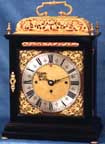 |
|
A VERY FINE AND MOST
IMPRESSIVE EBONY VENEER TABLE CLOCK ON TURNTABLE BASE, C. 1700. It has a beautifully executed fire-gilt repousse basket top decorated with fruit and flowers. There is a carrying handle on top and finials to the four corners. Decorative escutcheons have been applied to the front and back doors, the sides are glazed and it rests on bun feet. The turntable base has been re-instated. The massive 8 pillar movement with verge escapement chimes and repeats the quarters on six bells, and is signed on the beautiful florally engraved backplate. External clickwork is employed. The 9" square dial has a matted centre, strike/silent regulation above 12 o’clock and an aperture for the date below. The engraved and silvered brass chapter ring has Arabic minute and Roman hour numerals with half hour marks. This clock must have been made for a very important home, but unfortunately, the provenance is not known. Height with/without handle: 20.5"/18" Thomas Bradford was born C. 1659 and apprenticed to Joseph Windmills until 1680, when he gained his Freedom of the Clockmakers Company. He took as apprentices Bryon Thornhill (1683), Thomas Ashton (1687), William Sims (1693), William Hornblower, Thomas Taylor (1700) and Francis Speed (1707). He probably worked until 1710. |